RMIT University: Leadership Skills Development Plan Report
VerifiedAdded on 2022/10/01
|21
|3633
|354
Report
AI Summary
This report presents a comprehensive leadership development plan, structured in three stages: observation, planning, and feedback. The observation stage analyzes the leadership traits, behaviors, and qualities of Bill Gates, focusing on his transformational leadership style, emphasis on creativity, and philanthropic efforts. The planning stage involves self-assessment using diagnostic tools like team leadership skills, locus of control, and cultural intelligence to identify strengths and weaknesses. A leadership development plan template is then created, outlining goals, activities, timeframes, and measurement indicators. The plan aims to improve communication, leadership ability, and organizational influence. Finally, the report emphasizes the importance of seeking feedback from industry leaders to refine the plan, incorporating insights and suggestions for improvement. This structured approach provides a practical framework for enhancing leadership skills and effectiveness.
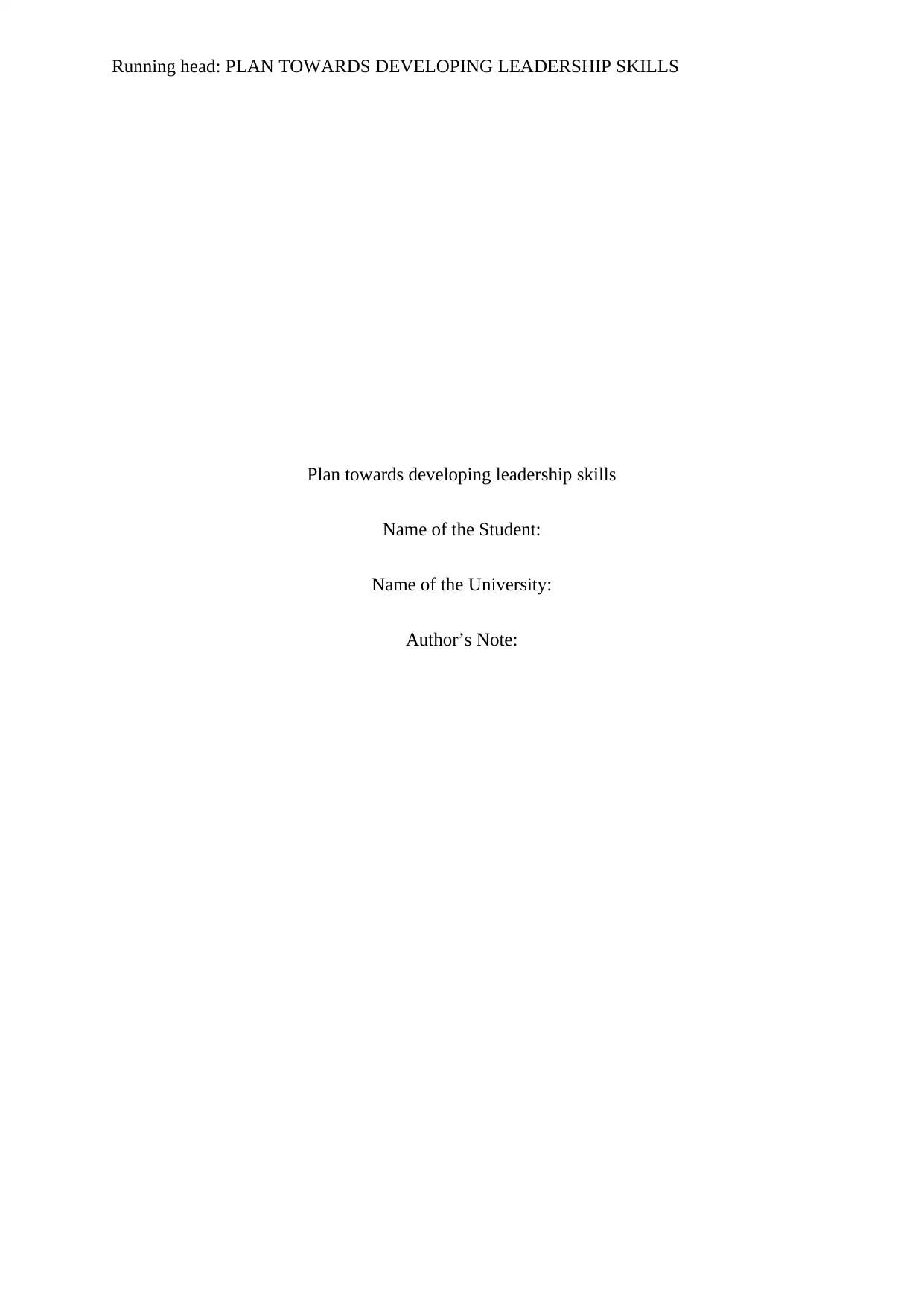
Running head: PLAN TOWARDS DEVELOPING LEADERSHIP SKILLS
Plan towards developing leadership skills
Name of the Student:
Name of the University:
Author’s Note:
Plan towards developing leadership skills
Name of the Student:
Name of the University:
Author’s Note:
Paraphrase This Document
Need a fresh take? Get an instant paraphrase of this document with our AI Paraphraser
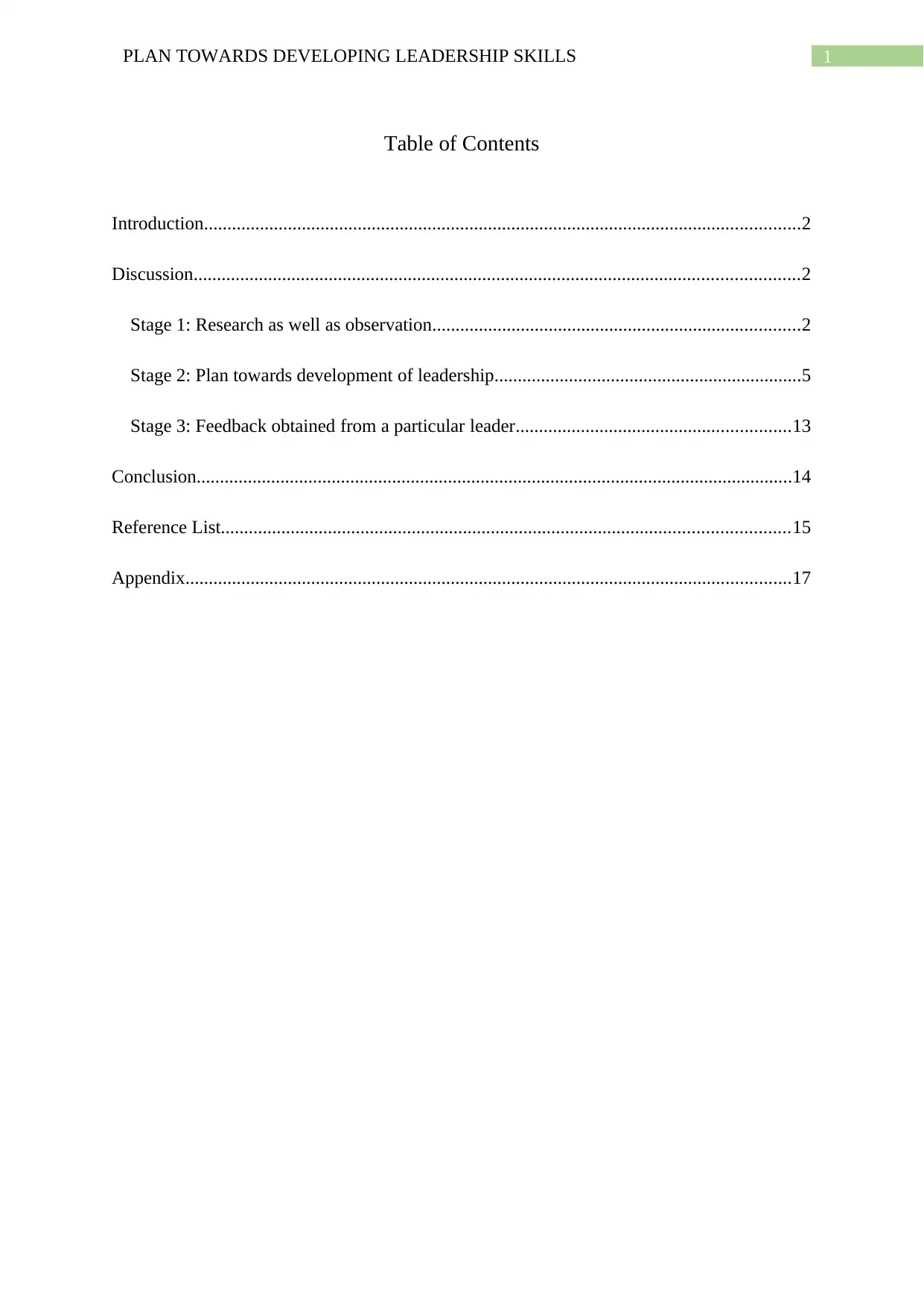
1PLAN TOWARDS DEVELOPING LEADERSHIP SKILLS
Table of Contents
Introduction................................................................................................................................2
Discussion..................................................................................................................................2
Stage 1: Research as well as observation...............................................................................2
Stage 2: Plan towards development of leadership..................................................................5
Stage 3: Feedback obtained from a particular leader...........................................................13
Conclusion................................................................................................................................14
Reference List..........................................................................................................................15
Appendix..................................................................................................................................17
Table of Contents
Introduction................................................................................................................................2
Discussion..................................................................................................................................2
Stage 1: Research as well as observation...............................................................................2
Stage 2: Plan towards development of leadership..................................................................5
Stage 3: Feedback obtained from a particular leader...........................................................13
Conclusion................................................................................................................................14
Reference List..........................................................................................................................15
Appendix..................................................................................................................................17
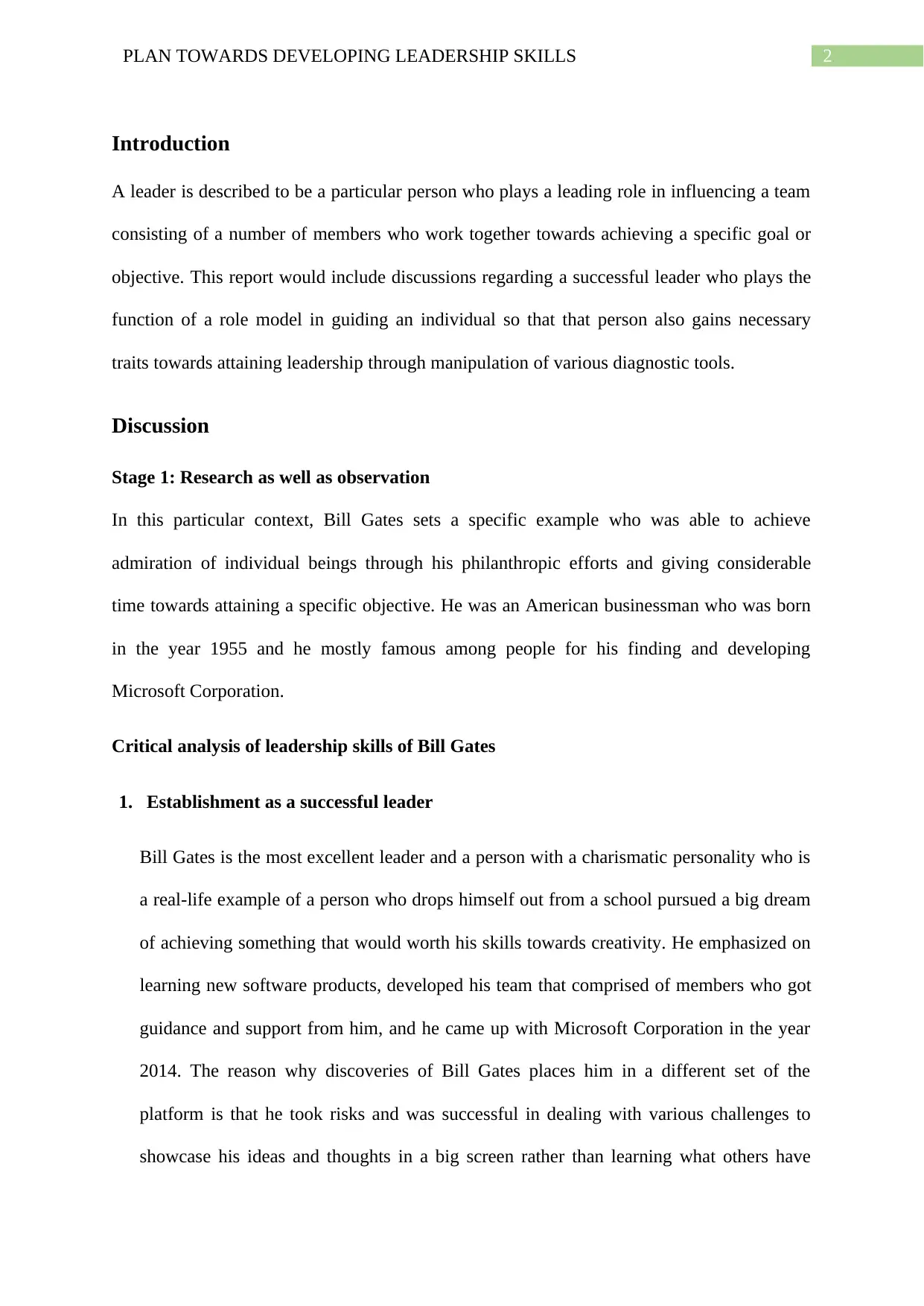
2PLAN TOWARDS DEVELOPING LEADERSHIP SKILLS
Introduction
A leader is described to be a particular person who plays a leading role in influencing a team
consisting of a number of members who work together towards achieving a specific goal or
objective. This report would include discussions regarding a successful leader who plays the
function of a role model in guiding an individual so that that person also gains necessary
traits towards attaining leadership through manipulation of various diagnostic tools.
Discussion
Stage 1: Research as well as observation
In this particular context, Bill Gates sets a specific example who was able to achieve
admiration of individual beings through his philanthropic efforts and giving considerable
time towards attaining a specific objective. He was an American businessman who was born
in the year 1955 and he mostly famous among people for his finding and developing
Microsoft Corporation.
Critical analysis of leadership skills of Bill Gates
1. Establishment as a successful leader
Bill Gates is the most excellent leader and a person with a charismatic personality who is
a real-life example of a person who drops himself out from a school pursued a big dream
of achieving something that would worth his skills towards creativity. He emphasized on
learning new software products, developed his team that comprised of members who got
guidance and support from him, and he came up with Microsoft Corporation in the year
2014. The reason why discoveries of Bill Gates places him in a different set of the
platform is that he took risks and was successful in dealing with various challenges to
showcase his ideas and thoughts in a big screen rather than learning what others have
Introduction
A leader is described to be a particular person who plays a leading role in influencing a team
consisting of a number of members who work together towards achieving a specific goal or
objective. This report would include discussions regarding a successful leader who plays the
function of a role model in guiding an individual so that that person also gains necessary
traits towards attaining leadership through manipulation of various diagnostic tools.
Discussion
Stage 1: Research as well as observation
In this particular context, Bill Gates sets a specific example who was able to achieve
admiration of individual beings through his philanthropic efforts and giving considerable
time towards attaining a specific objective. He was an American businessman who was born
in the year 1955 and he mostly famous among people for his finding and developing
Microsoft Corporation.
Critical analysis of leadership skills of Bill Gates
1. Establishment as a successful leader
Bill Gates is the most excellent leader and a person with a charismatic personality who is
a real-life example of a person who drops himself out from a school pursued a big dream
of achieving something that would worth his skills towards creativity. He emphasized on
learning new software products, developed his team that comprised of members who got
guidance and support from him, and he came up with Microsoft Corporation in the year
2014. The reason why discoveries of Bill Gates places him in a different set of the
platform is that he took risks and was successful in dealing with various challenges to
showcase his ideas and thoughts in a big screen rather than learning what others have
⊘ This is a preview!⊘
Do you want full access?
Subscribe today to unlock all pages.

Trusted by 1+ million students worldwide
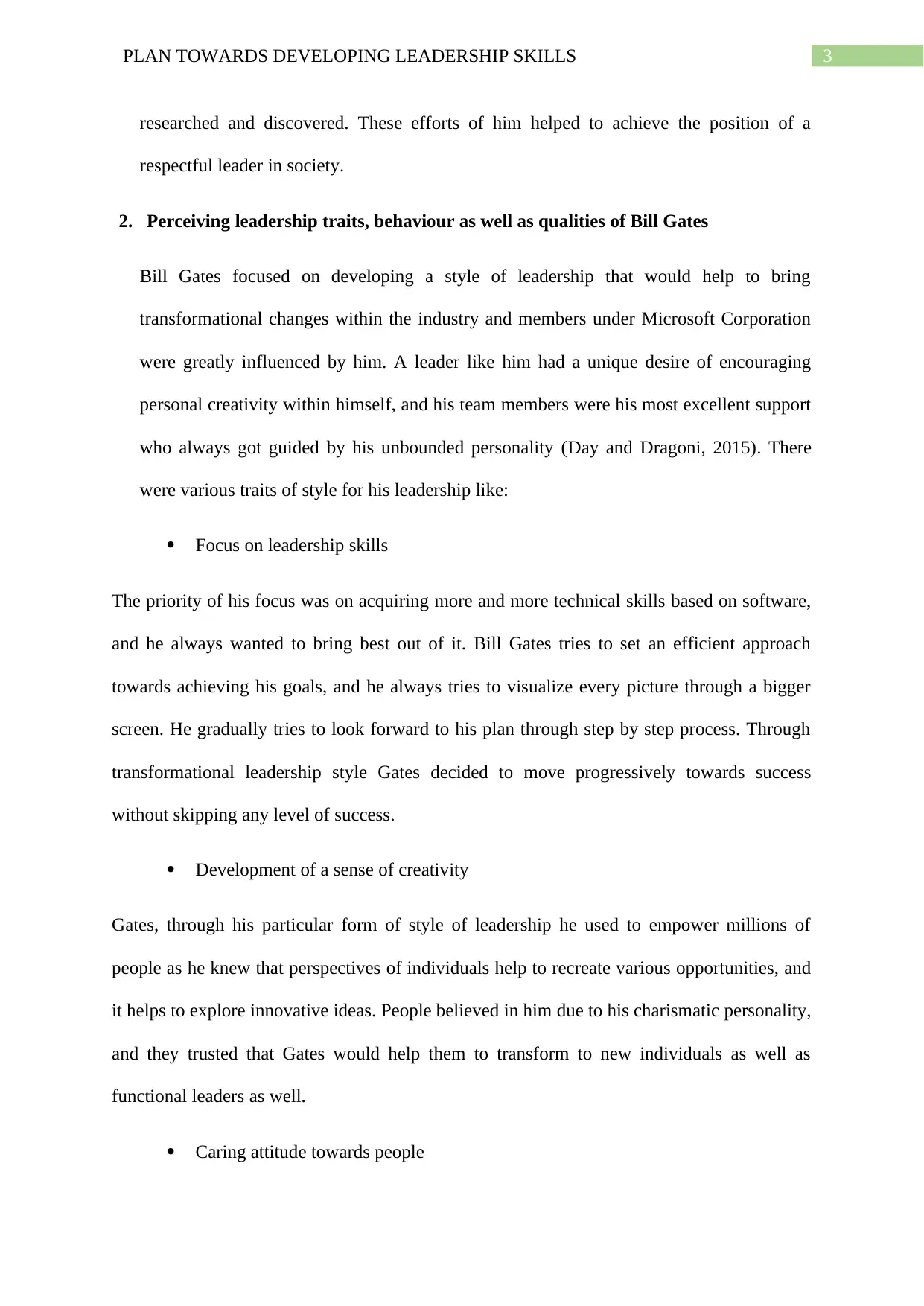
3PLAN TOWARDS DEVELOPING LEADERSHIP SKILLS
researched and discovered. These efforts of him helped to achieve the position of a
respectful leader in society.
2. Perceiving leadership traits, behaviour as well as qualities of Bill Gates
Bill Gates focused on developing a style of leadership that would help to bring
transformational changes within the industry and members under Microsoft Corporation
were greatly influenced by him. A leader like him had a unique desire of encouraging
personal creativity within himself, and his team members were his most excellent support
who always got guided by his unbounded personality (Day and Dragoni, 2015). There
were various traits of style for his leadership like:
Focus on leadership skills
The priority of his focus was on acquiring more and more technical skills based on software,
and he always wanted to bring best out of it. Bill Gates tries to set an efficient approach
towards achieving his goals, and he always tries to visualize every picture through a bigger
screen. He gradually tries to look forward to his plan through step by step process. Through
transformational leadership style Gates decided to move progressively towards success
without skipping any level of success.
Development of a sense of creativity
Gates, through his particular form of style of leadership he used to empower millions of
people as he knew that perspectives of individuals help to recreate various opportunities, and
it helps to explore innovative ideas. People believed in him due to his charismatic personality,
and they trusted that Gates would help them to transform to new individuals as well as
functional leaders as well.
Caring attitude towards people
researched and discovered. These efforts of him helped to achieve the position of a
respectful leader in society.
2. Perceiving leadership traits, behaviour as well as qualities of Bill Gates
Bill Gates focused on developing a style of leadership that would help to bring
transformational changes within the industry and members under Microsoft Corporation
were greatly influenced by him. A leader like him had a unique desire of encouraging
personal creativity within himself, and his team members were his most excellent support
who always got guided by his unbounded personality (Day and Dragoni, 2015). There
were various traits of style for his leadership like:
Focus on leadership skills
The priority of his focus was on acquiring more and more technical skills based on software,
and he always wanted to bring best out of it. Bill Gates tries to set an efficient approach
towards achieving his goals, and he always tries to visualize every picture through a bigger
screen. He gradually tries to look forward to his plan through step by step process. Through
transformational leadership style Gates decided to move progressively towards success
without skipping any level of success.
Development of a sense of creativity
Gates, through his particular form of style of leadership he used to empower millions of
people as he knew that perspectives of individuals help to recreate various opportunities, and
it helps to explore innovative ideas. People believed in him due to his charismatic personality,
and they trusted that Gates would help them to transform to new individuals as well as
functional leaders as well.
Caring attitude towards people
Paraphrase This Document
Need a fresh take? Get an instant paraphrase of this document with our AI Paraphraser
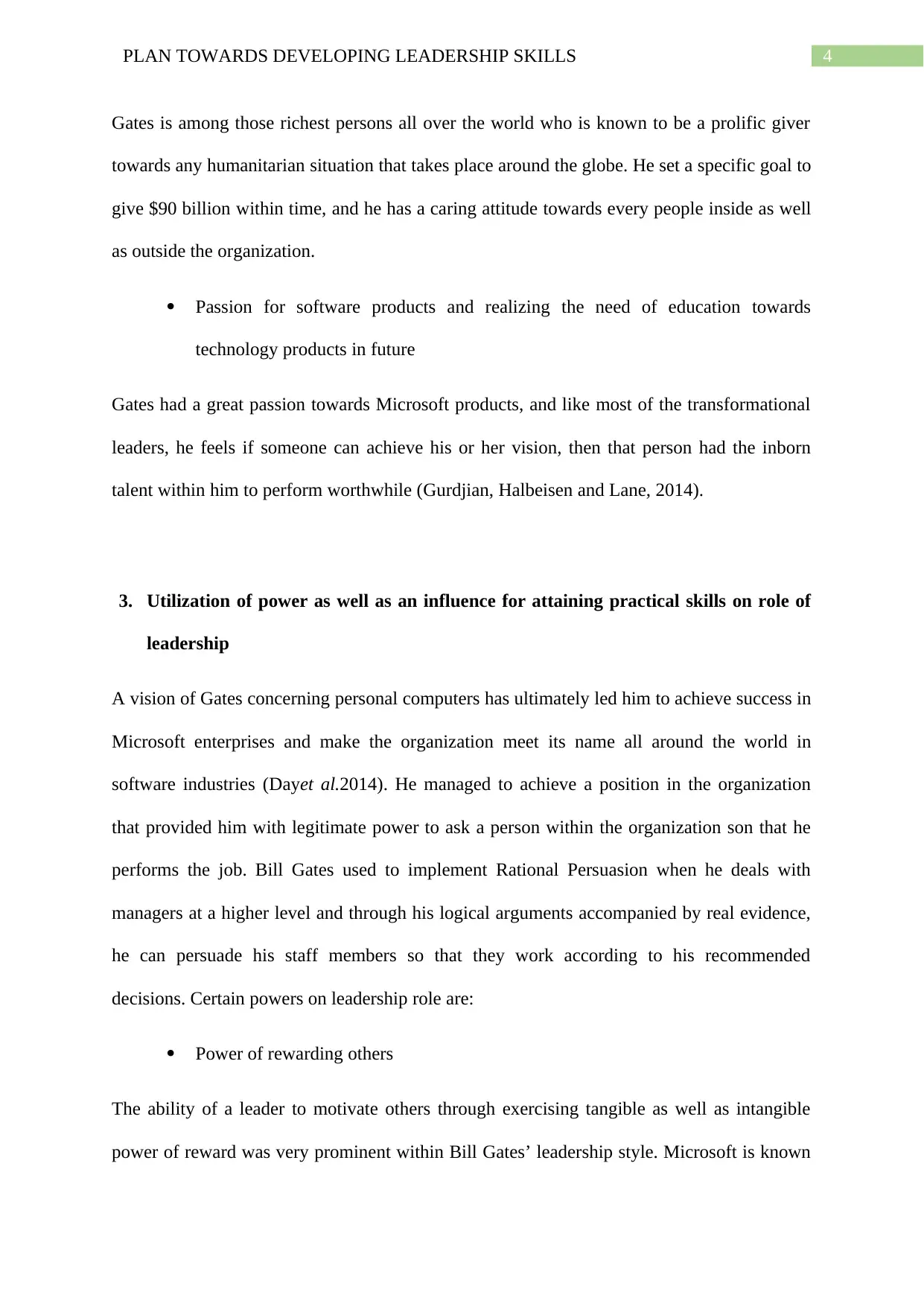
4PLAN TOWARDS DEVELOPING LEADERSHIP SKILLS
Gates is among those richest persons all over the world who is known to be a prolific giver
towards any humanitarian situation that takes place around the globe. He set a specific goal to
give $90 billion within time, and he has a caring attitude towards every people inside as well
as outside the organization.
Passion for software products and realizing the need of education towards
technology products in future
Gates had a great passion towards Microsoft products, and like most of the transformational
leaders, he feels if someone can achieve his or her vision, then that person had the inborn
talent within him to perform worthwhile (Gurdjian, Halbeisen and Lane, 2014).
3. Utilization of power as well as an influence for attaining practical skills on role of
leadership
A vision of Gates concerning personal computers has ultimately led him to achieve success in
Microsoft enterprises and make the organization meet its name all around the world in
software industries (Dayet al.2014). He managed to achieve a position in the organization
that provided him with legitimate power to ask a person within the organization son that he
performs the job. Bill Gates used to implement Rational Persuasion when he deals with
managers at a higher level and through his logical arguments accompanied by real evidence,
he can persuade his staff members so that they work according to his recommended
decisions. Certain powers on leadership role are:
Power of rewarding others
The ability of a leader to motivate others through exercising tangible as well as intangible
power of reward was very prominent within Bill Gates’ leadership style. Microsoft is known
Gates is among those richest persons all over the world who is known to be a prolific giver
towards any humanitarian situation that takes place around the globe. He set a specific goal to
give $90 billion within time, and he has a caring attitude towards every people inside as well
as outside the organization.
Passion for software products and realizing the need of education towards
technology products in future
Gates had a great passion towards Microsoft products, and like most of the transformational
leaders, he feels if someone can achieve his or her vision, then that person had the inborn
talent within him to perform worthwhile (Gurdjian, Halbeisen and Lane, 2014).
3. Utilization of power as well as an influence for attaining practical skills on role of
leadership
A vision of Gates concerning personal computers has ultimately led him to achieve success in
Microsoft enterprises and make the organization meet its name all around the world in
software industries (Dayet al.2014). He managed to achieve a position in the organization
that provided him with legitimate power to ask a person within the organization son that he
performs the job. Bill Gates used to implement Rational Persuasion when he deals with
managers at a higher level and through his logical arguments accompanied by real evidence,
he can persuade his staff members so that they work according to his recommended
decisions. Certain powers on leadership role are:
Power of rewarding others
The ability of a leader to motivate others through exercising tangible as well as intangible
power of reward was very prominent within Bill Gates’ leadership style. Microsoft is known
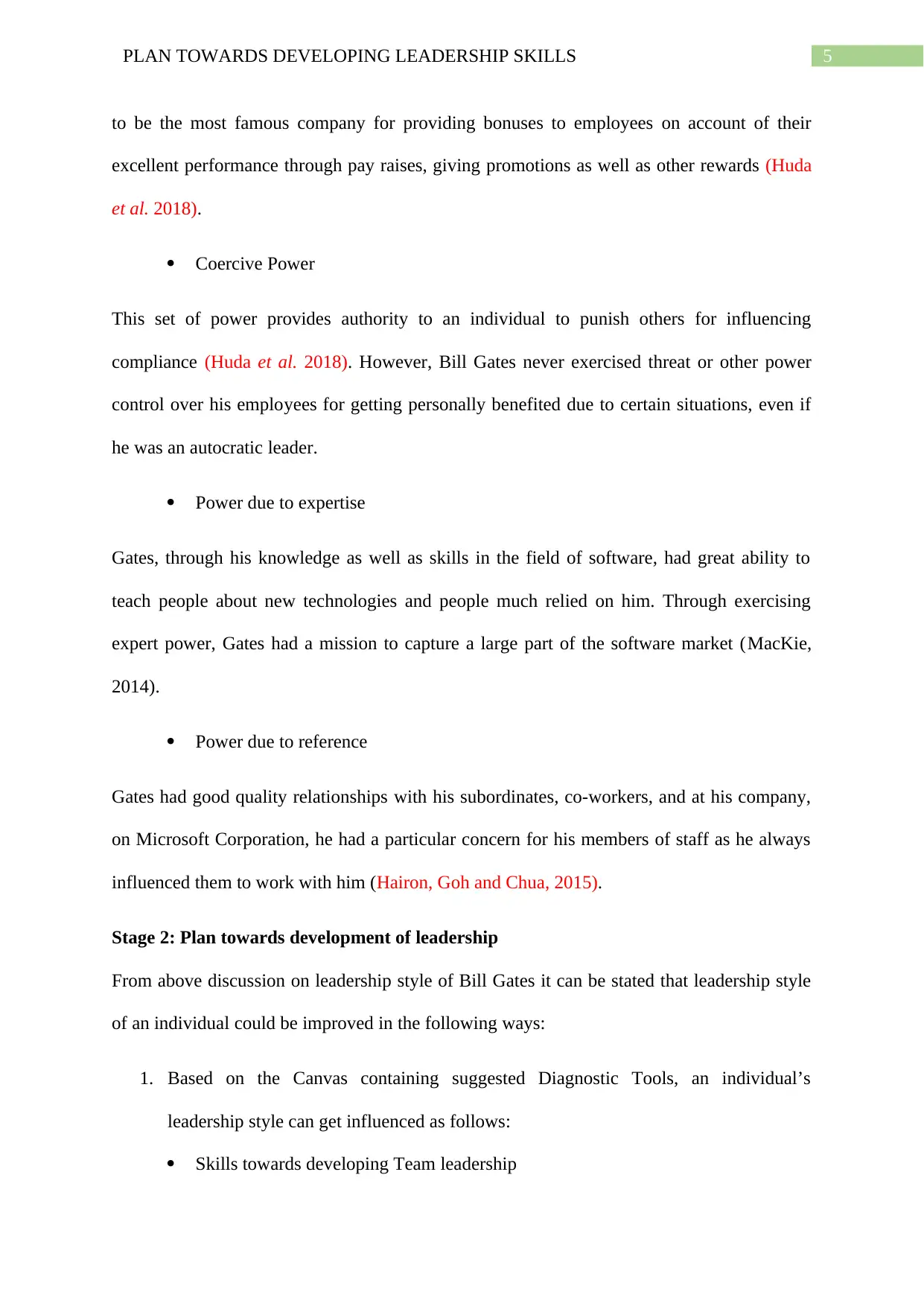
5PLAN TOWARDS DEVELOPING LEADERSHIP SKILLS
to be the most famous company for providing bonuses to employees on account of their
excellent performance through pay raises, giving promotions as well as other rewards (Huda
et al. 2018).
Coercive Power
This set of power provides authority to an individual to punish others for influencing
compliance (Huda et al. 2018). However, Bill Gates never exercised threat or other power
control over his employees for getting personally benefited due to certain situations, even if
he was an autocratic leader.
Power due to expertise
Gates, through his knowledge as well as skills in the field of software, had great ability to
teach people about new technologies and people much relied on him. Through exercising
expert power, Gates had a mission to capture a large part of the software market (MacKie,
2014).
Power due to reference
Gates had good quality relationships with his subordinates, co-workers, and at his company,
on Microsoft Corporation, he had a particular concern for his members of staff as he always
influenced them to work with him (Hairon, Goh and Chua, 2015).
Stage 2: Plan towards development of leadership
From above discussion on leadership style of Bill Gates it can be stated that leadership style
of an individual could be improved in the following ways:
1. Based on the Canvas containing suggested Diagnostic Tools, an individual’s
leadership style can get influenced as follows:
Skills towards developing Team leadership
to be the most famous company for providing bonuses to employees on account of their
excellent performance through pay raises, giving promotions as well as other rewards (Huda
et al. 2018).
Coercive Power
This set of power provides authority to an individual to punish others for influencing
compliance (Huda et al. 2018). However, Bill Gates never exercised threat or other power
control over his employees for getting personally benefited due to certain situations, even if
he was an autocratic leader.
Power due to expertise
Gates, through his knowledge as well as skills in the field of software, had great ability to
teach people about new technologies and people much relied on him. Through exercising
expert power, Gates had a mission to capture a large part of the software market (MacKie,
2014).
Power due to reference
Gates had good quality relationships with his subordinates, co-workers, and at his company,
on Microsoft Corporation, he had a particular concern for his members of staff as he always
influenced them to work with him (Hairon, Goh and Chua, 2015).
Stage 2: Plan towards development of leadership
From above discussion on leadership style of Bill Gates it can be stated that leadership style
of an individual could be improved in the following ways:
1. Based on the Canvas containing suggested Diagnostic Tools, an individual’s
leadership style can get influenced as follows:
Skills towards developing Team leadership
⊘ This is a preview!⊘
Do you want full access?
Subscribe today to unlock all pages.

Trusted by 1+ million students worldwide
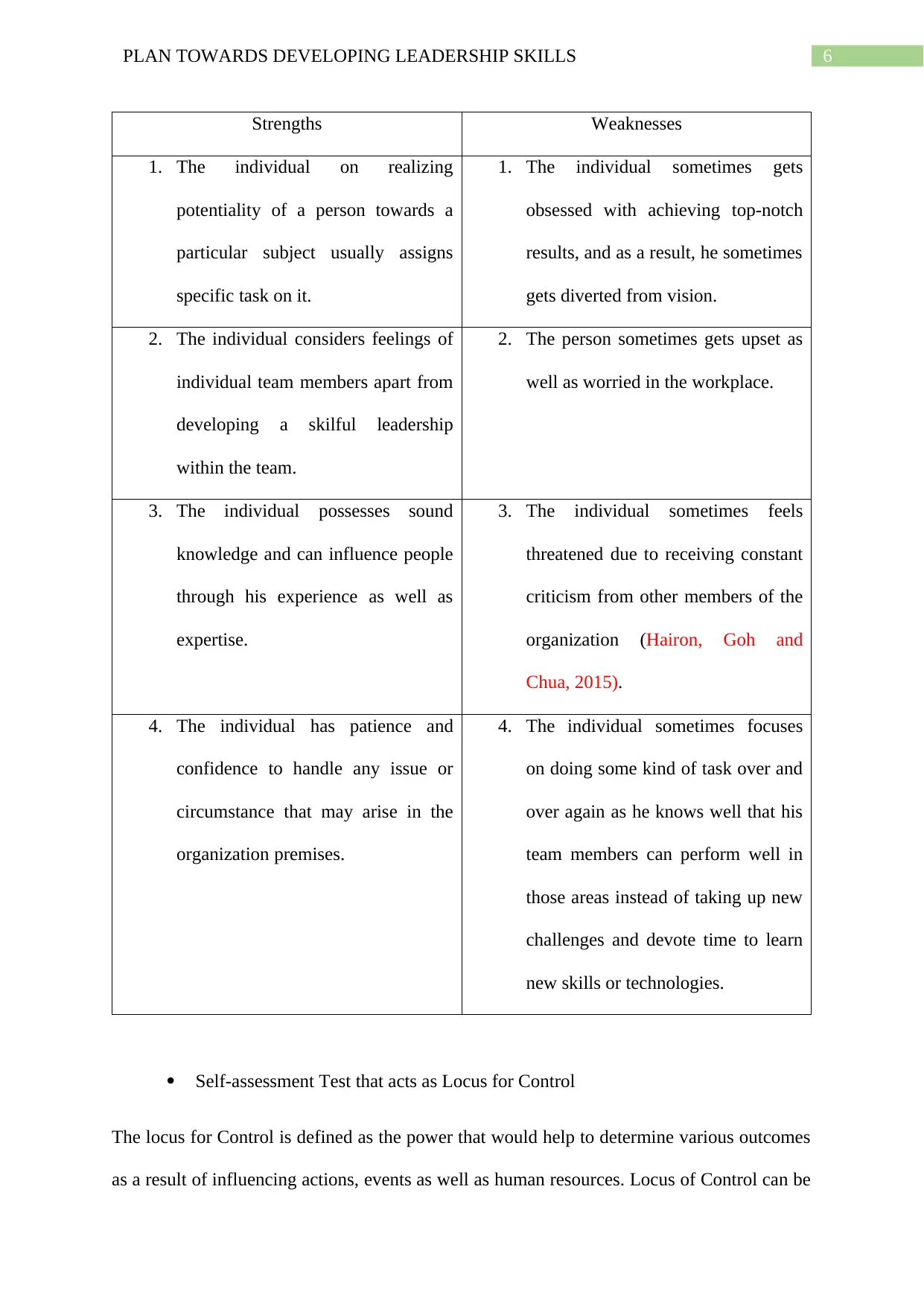
6PLAN TOWARDS DEVELOPING LEADERSHIP SKILLS
Strengths Weaknesses
1. The individual on realizing
potentiality of a person towards a
particular subject usually assigns
specific task on it.
1. The individual sometimes gets
obsessed with achieving top-notch
results, and as a result, he sometimes
gets diverted from vision.
2. The individual considers feelings of
individual team members apart from
developing a skilful leadership
within the team.
2. The person sometimes gets upset as
well as worried in the workplace.
3. The individual possesses sound
knowledge and can influence people
through his experience as well as
expertise.
3. The individual sometimes feels
threatened due to receiving constant
criticism from other members of the
organization (Hairon, Goh and
Chua, 2015).
4. The individual has patience and
confidence to handle any issue or
circumstance that may arise in the
organization premises.
4. The individual sometimes focuses
on doing some kind of task over and
over again as he knows well that his
team members can perform well in
those areas instead of taking up new
challenges and devote time to learn
new skills or technologies.
Self-assessment Test that acts as Locus for Control
The locus for Control is defined as the power that would help to determine various outcomes
as a result of influencing actions, events as well as human resources. Locus of Control can be
Strengths Weaknesses
1. The individual on realizing
potentiality of a person towards a
particular subject usually assigns
specific task on it.
1. The individual sometimes gets
obsessed with achieving top-notch
results, and as a result, he sometimes
gets diverted from vision.
2. The individual considers feelings of
individual team members apart from
developing a skilful leadership
within the team.
2. The person sometimes gets upset as
well as worried in the workplace.
3. The individual possesses sound
knowledge and can influence people
through his experience as well as
expertise.
3. The individual sometimes feels
threatened due to receiving constant
criticism from other members of the
organization (Hairon, Goh and
Chua, 2015).
4. The individual has patience and
confidence to handle any issue or
circumstance that may arise in the
organization premises.
4. The individual sometimes focuses
on doing some kind of task over and
over again as he knows well that his
team members can perform well in
those areas instead of taking up new
challenges and devote time to learn
new skills or technologies.
Self-assessment Test that acts as Locus for Control
The locus for Control is defined as the power that would help to determine various outcomes
as a result of influencing actions, events as well as human resources. Locus of Control can be
Paraphrase This Document
Need a fresh take? Get an instant paraphrase of this document with our AI Paraphraser
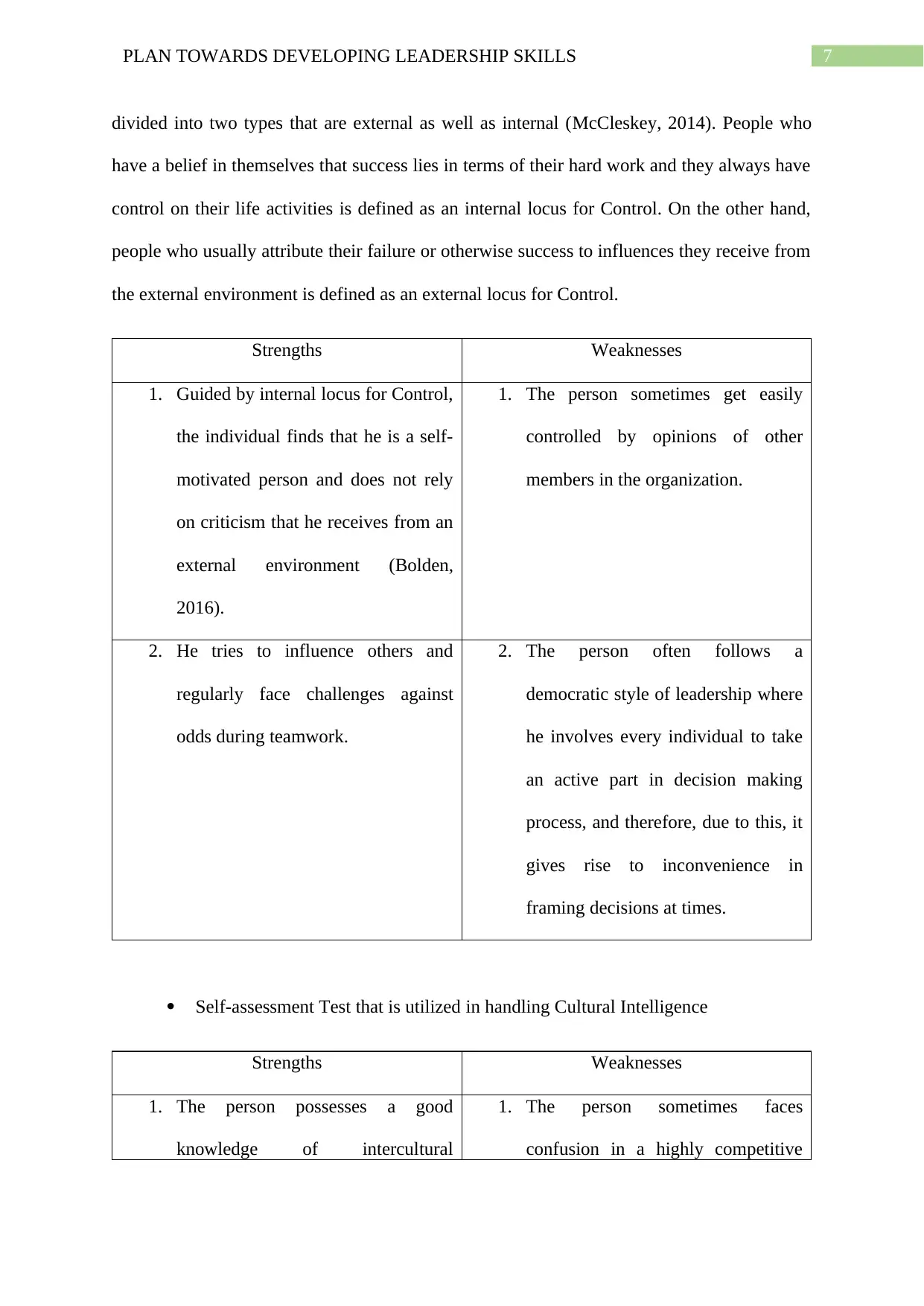
7PLAN TOWARDS DEVELOPING LEADERSHIP SKILLS
divided into two types that are external as well as internal (McCleskey, 2014). People who
have a belief in themselves that success lies in terms of their hard work and they always have
control on their life activities is defined as an internal locus for Control. On the other hand,
people who usually attribute their failure or otherwise success to influences they receive from
the external environment is defined as an external locus for Control.
Strengths Weaknesses
1. Guided by internal locus for Control,
the individual finds that he is a self-
motivated person and does not rely
on criticism that he receives from an
external environment (Bolden,
2016).
1. The person sometimes get easily
controlled by opinions of other
members in the organization.
2. He tries to influence others and
regularly face challenges against
odds during teamwork.
2. The person often follows a
democratic style of leadership where
he involves every individual to take
an active part in decision making
process, and therefore, due to this, it
gives rise to inconvenience in
framing decisions at times.
Self-assessment Test that is utilized in handling Cultural Intelligence
Strengths Weaknesses
1. The person possesses a good
knowledge of intercultural
1. The person sometimes faces
confusion in a highly competitive
divided into two types that are external as well as internal (McCleskey, 2014). People who
have a belief in themselves that success lies in terms of their hard work and they always have
control on their life activities is defined as an internal locus for Control. On the other hand,
people who usually attribute their failure or otherwise success to influences they receive from
the external environment is defined as an external locus for Control.
Strengths Weaknesses
1. Guided by internal locus for Control,
the individual finds that he is a self-
motivated person and does not rely
on criticism that he receives from an
external environment (Bolden,
2016).
1. The person sometimes get easily
controlled by opinions of other
members in the organization.
2. He tries to influence others and
regularly face challenges against
odds during teamwork.
2. The person often follows a
democratic style of leadership where
he involves every individual to take
an active part in decision making
process, and therefore, due to this, it
gives rise to inconvenience in
framing decisions at times.
Self-assessment Test that is utilized in handling Cultural Intelligence
Strengths Weaknesses
1. The person possesses a good
knowledge of intercultural
1. The person sometimes faces
confusion in a highly competitive
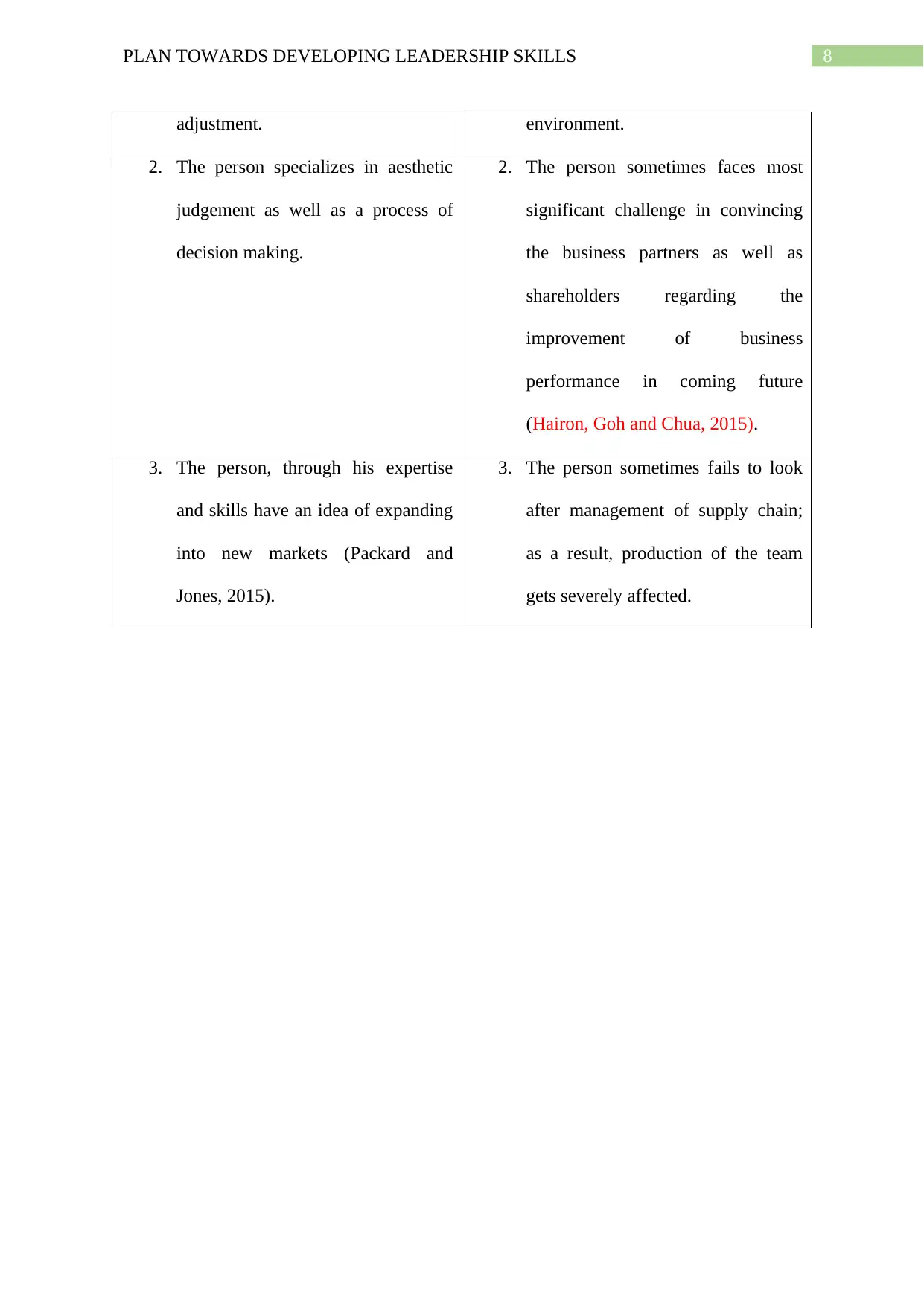
8PLAN TOWARDS DEVELOPING LEADERSHIP SKILLS
adjustment. environment.
2. The person specializes in aesthetic
judgement as well as a process of
decision making.
2. The person sometimes faces most
significant challenge in convincing
the business partners as well as
shareholders regarding the
improvement of business
performance in coming future
(Hairon, Goh and Chua, 2015).
3. The person, through his expertise
and skills have an idea of expanding
into new markets (Packard and
Jones, 2015).
3. The person sometimes fails to look
after management of supply chain;
as a result, production of the team
gets severely affected.
adjustment. environment.
2. The person specializes in aesthetic
judgement as well as a process of
decision making.
2. The person sometimes faces most
significant challenge in convincing
the business partners as well as
shareholders regarding the
improvement of business
performance in coming future
(Hairon, Goh and Chua, 2015).
3. The person, through his expertise
and skills have an idea of expanding
into new markets (Packard and
Jones, 2015).
3. The person sometimes fails to look
after management of supply chain;
as a result, production of the team
gets severely affected.
⊘ This is a preview!⊘
Do you want full access?
Subscribe today to unlock all pages.

Trusted by 1+ million students worldwide
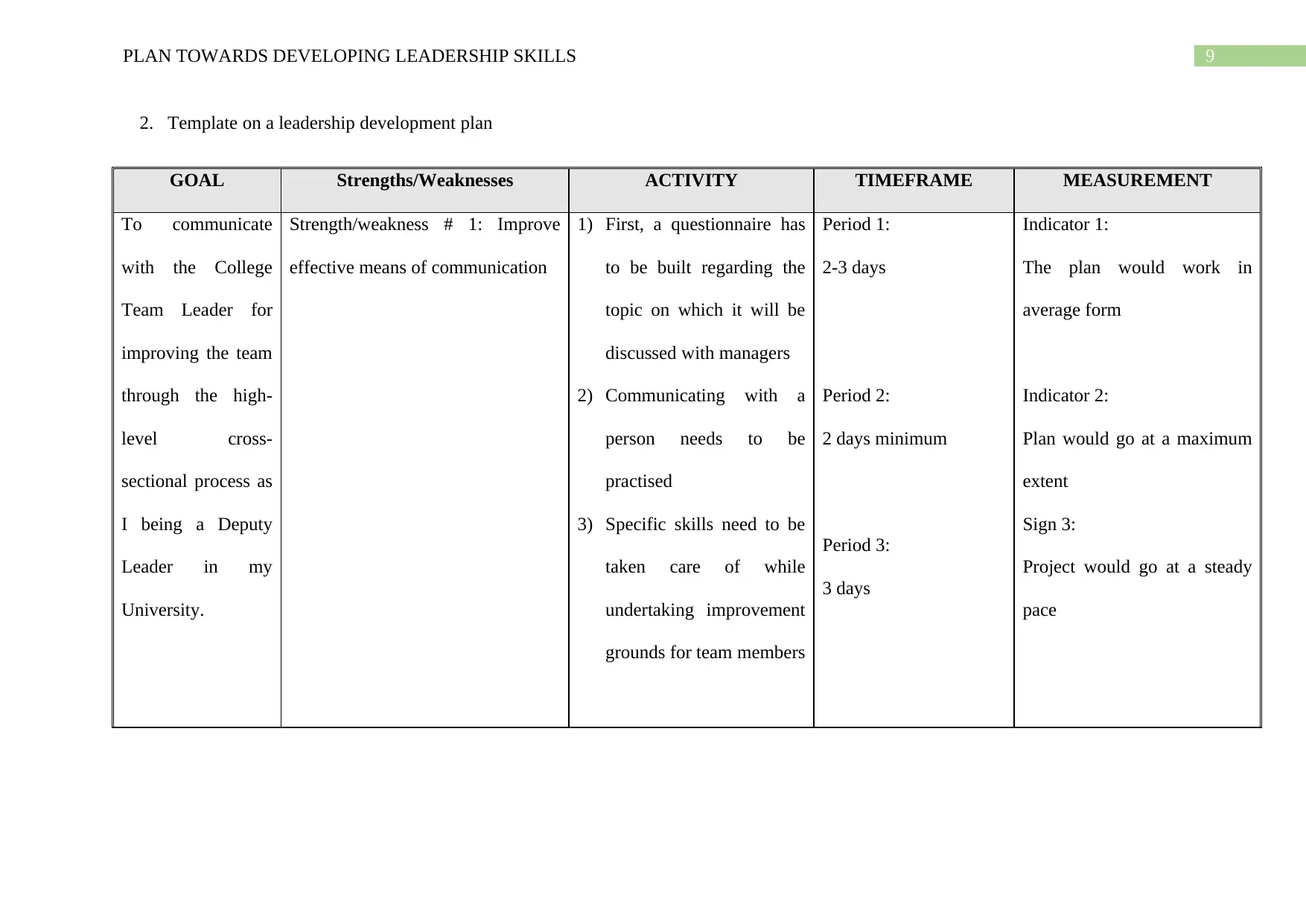
9PLAN TOWARDS DEVELOPING LEADERSHIP SKILLS
2. Template on a leadership development plan
GOAL Strengths/Weaknesses ACTIVITY TIMEFRAME MEASUREMENT
To communicate
with the College
Team Leader for
improving the team
through the high-
level cross-
sectional process as
I being a Deputy
Leader in my
University.
Strength/weakness # 1: Improve
effective means of communication
1) First, a questionnaire has
to be built regarding the
topic on which it will be
discussed with managers
2) Communicating with a
person needs to be
practised
3) Specific skills need to be
taken care of while
undertaking improvement
grounds for team members
Period 1:
2-3 days
Period 2:
2 days minimum
Period 3:
3 days
Indicator 1:
The plan would work in
average form
Indicator 2:
Plan would go at a maximum
extent
Sign 3:
Project would go at a steady
pace
2. Template on a leadership development plan
GOAL Strengths/Weaknesses ACTIVITY TIMEFRAME MEASUREMENT
To communicate
with the College
Team Leader for
improving the team
through the high-
level cross-
sectional process as
I being a Deputy
Leader in my
University.
Strength/weakness # 1: Improve
effective means of communication
1) First, a questionnaire has
to be built regarding the
topic on which it will be
discussed with managers
2) Communicating with a
person needs to be
practised
3) Specific skills need to be
taken care of while
undertaking improvement
grounds for team members
Period 1:
2-3 days
Period 2:
2 days minimum
Period 3:
3 days
Indicator 1:
The plan would work in
average form
Indicator 2:
Plan would go at a maximum
extent
Sign 3:
Project would go at a steady
pace
Paraphrase This Document
Need a fresh take? Get an instant paraphrase of this document with our AI Paraphraser
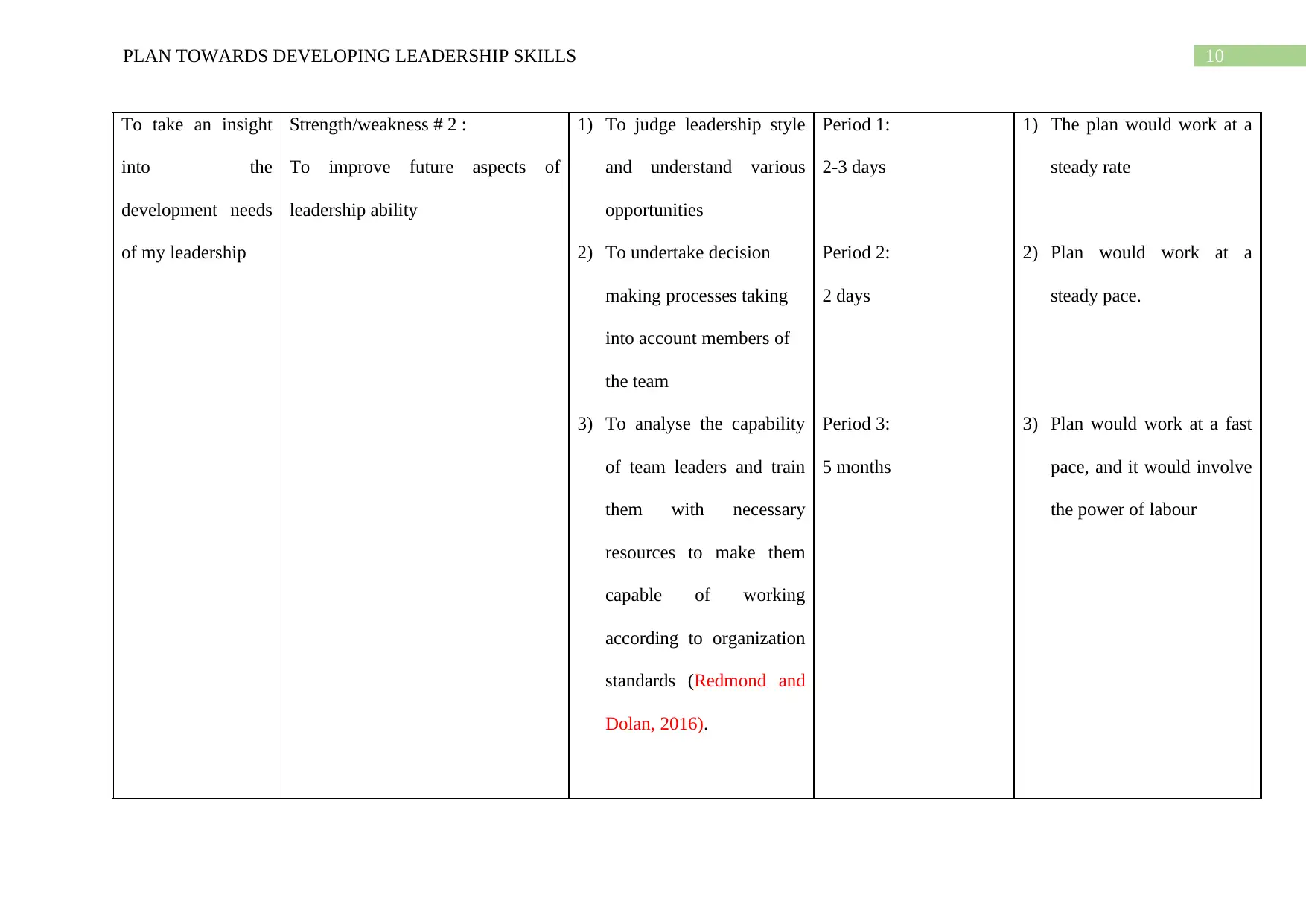
10PLAN TOWARDS DEVELOPING LEADERSHIP SKILLS
To take an insight
into the
development needs
of my leadership
Strength/weakness # 2 :
To improve future aspects of
leadership ability
1) To judge leadership style
and understand various
opportunities
2) To undertake decision
making processes taking
into account members of
the team
3) To analyse the capability
of team leaders and train
them with necessary
resources to make them
capable of working
according to organization
standards (Redmond and
Dolan, 2016).
Period 1:
2-3 days
Period 2:
2 days
Period 3:
5 months
1) The plan would work at a
steady rate
2) Plan would work at a
steady pace.
3) Plan would work at a fast
pace, and it would involve
the power of labour
To take an insight
into the
development needs
of my leadership
Strength/weakness # 2 :
To improve future aspects of
leadership ability
1) To judge leadership style
and understand various
opportunities
2) To undertake decision
making processes taking
into account members of
the team
3) To analyse the capability
of team leaders and train
them with necessary
resources to make them
capable of working
according to organization
standards (Redmond and
Dolan, 2016).
Period 1:
2-3 days
Period 2:
2 days
Period 3:
5 months
1) The plan would work at a
steady rate
2) Plan would work at a
steady pace.
3) Plan would work at a fast
pace, and it would involve
the power of labour
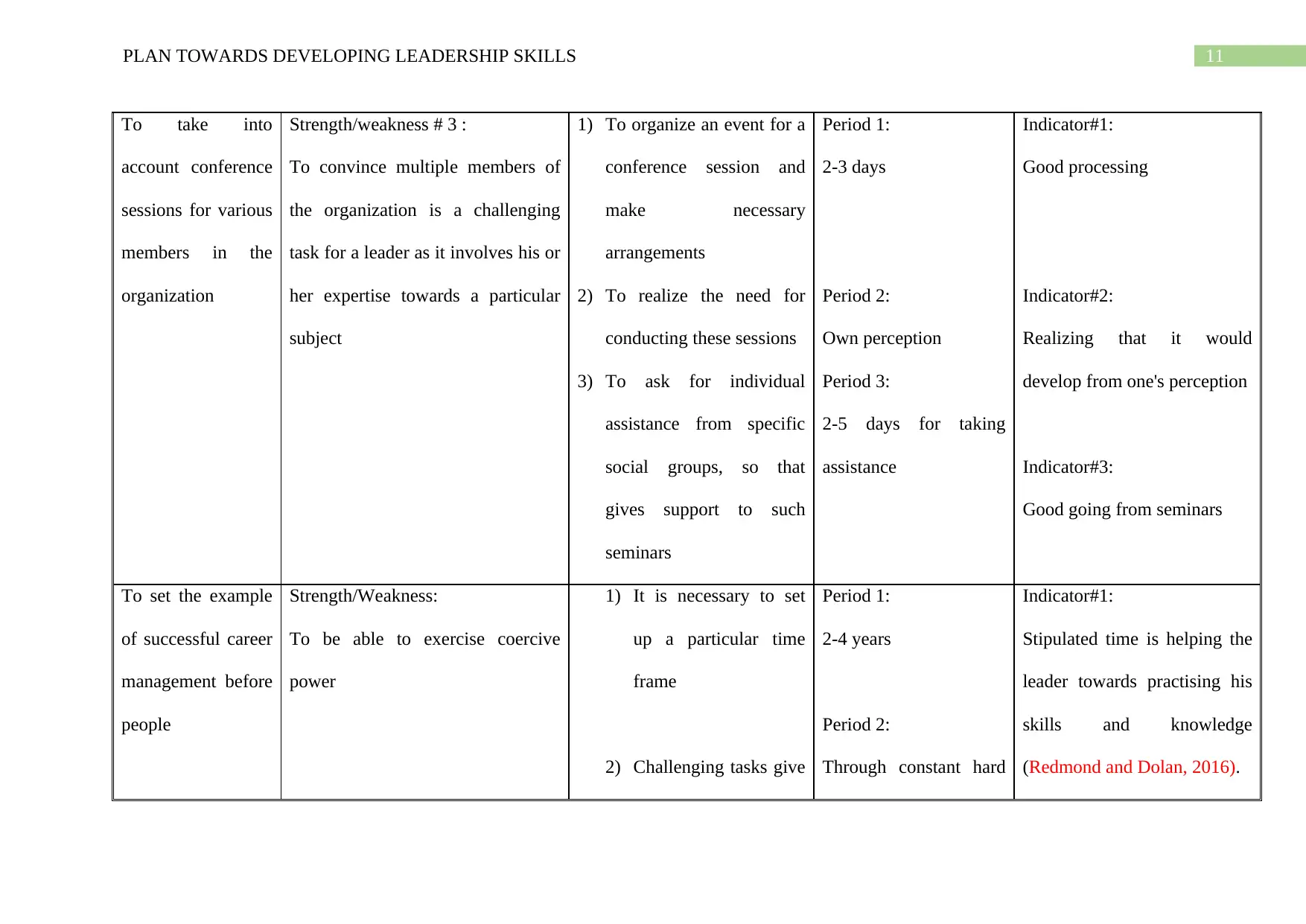
11PLAN TOWARDS DEVELOPING LEADERSHIP SKILLS
To take into
account conference
sessions for various
members in the
organization
Strength/weakness # 3 :
To convince multiple members of
the organization is a challenging
task for a leader as it involves his or
her expertise towards a particular
subject
1) To organize an event for a
conference session and
make necessary
arrangements
2) To realize the need for
conducting these sessions
3) To ask for individual
assistance from specific
social groups, so that
gives support to such
seminars
Period 1:
2-3 days
Period 2:
Own perception
Period 3:
2-5 days for taking
assistance
Indicator#1:
Good processing
Indicator#2:
Realizing that it would
develop from one's perception
Indicator#3:
Good going from seminars
To set the example
of successful career
management before
people
Strength/Weakness:
To be able to exercise coercive
power
1) It is necessary to set
up a particular time
frame
2) Challenging tasks give
Period 1:
2-4 years
Period 2:
Through constant hard
Indicator#1:
Stipulated time is helping the
leader towards practising his
skills and knowledge
(Redmond and Dolan, 2016).
To take into
account conference
sessions for various
members in the
organization
Strength/weakness # 3 :
To convince multiple members of
the organization is a challenging
task for a leader as it involves his or
her expertise towards a particular
subject
1) To organize an event for a
conference session and
make necessary
arrangements
2) To realize the need for
conducting these sessions
3) To ask for individual
assistance from specific
social groups, so that
gives support to such
seminars
Period 1:
2-3 days
Period 2:
Own perception
Period 3:
2-5 days for taking
assistance
Indicator#1:
Good processing
Indicator#2:
Realizing that it would
develop from one's perception
Indicator#3:
Good going from seminars
To set the example
of successful career
management before
people
Strength/Weakness:
To be able to exercise coercive
power
1) It is necessary to set
up a particular time
frame
2) Challenging tasks give
Period 1:
2-4 years
Period 2:
Through constant hard
Indicator#1:
Stipulated time is helping the
leader towards practising his
skills and knowledge
(Redmond and Dolan, 2016).
⊘ This is a preview!⊘
Do you want full access?
Subscribe today to unlock all pages.

Trusted by 1+ million students worldwide
1 out of 21
Related Documents
Your All-in-One AI-Powered Toolkit for Academic Success.
+13062052269
info@desklib.com
Available 24*7 on WhatsApp / Email
![[object Object]](/_next/static/media/star-bottom.7253800d.svg)
Unlock your academic potential
Copyright © 2020–2025 A2Z Services. All Rights Reserved. Developed and managed by ZUCOL.





![Leadership and Management Reflection Report - [Course Name]](/_next/image/?url=https%3A%2F%2Fdesklib.com%2Fmedia%2Fimages%2Ftd%2F609a50cd4c7044d196b9d89d4e436278.jpg&w=256&q=75)